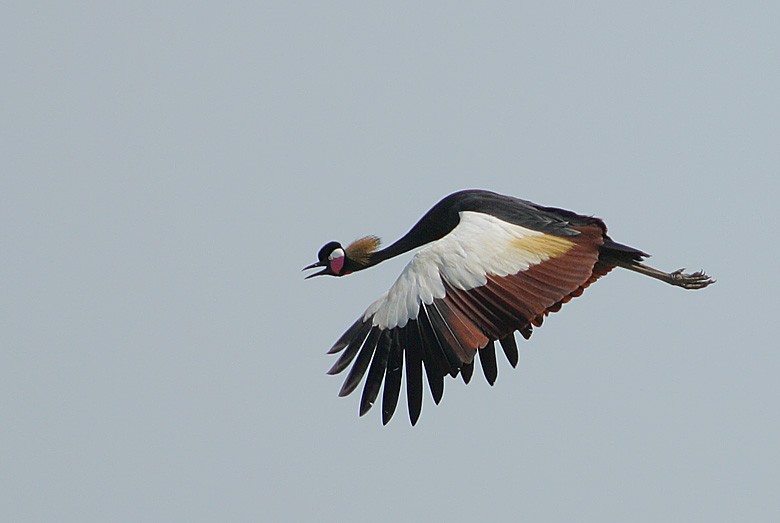Black Crowned Crane
A species of Crowned-cranes Scientific name : Balearica pavonina Genus : Crowned-cranes
Black Crowned Crane, A species of Crowned-cranes
Botanical name: Balearica pavonina
Genus: Crowned-cranes
Content
Description General Info
 Photo By Steve Garvie , used under CC-BY-SA-2.0 /Cropped and compressed from original
Photo By Steve Garvie , used under CC-BY-SA-2.0 /Cropped and compressed from original Description
The black crowned crane can measure up to 105 cm in length, weigh between 3000-4000 g and has a wingspan of 180–200 cm. Naturally, it is characterized by its dark slate-grey to black plumage, and it has stiff golden feathers at the top of its head which make up its crown. Each golden bristle-like feather is a spiral that is white on one side and brown on the other with black at the very tip. Other distinct features of these birds include the white feathers on the upper section of their wings and the small pouch of red skin, the gular sac, hanging underneath their chins. Their long legs and their toes are black, and they possess a long hind toe that allows them to grasp onto perches. The black crowned crane also has large red cheek patches just behind its eye that differ in size between its two subspecies; the West African black crowned crane (Balearica pavonina pavonina) has red on the lower half of its cheek patch while the Sudan black crowned crane (Balearica pavonine ceciliae) has red extending to the upper half as well. Male black crowned cranes are larger but are otherwise indistinguishable from females. Juveniles are mostly grey with a brown crown and a nape, grey to brown body. 
Size
1.05 m
Life Expectancy
20 years
Nest Placement
Ground
Feeding Habits
Black Crowned Crane primarily feed on a wide range of items including insects, mollusks, crustaceans, and seeds. They use foraging techniques to hunt prey and consume plant matter like grass tips and crops. Notably, black Crowned Crane have a preference for certain grains such as millet, corn, and rice.
Habitat
The black Crowned Crane thrives in a mosaic of wet and dry habitats, predominantly frequenting wetlands—such as flooded lowlands, marshes, and meadow margins by water bodies like ponds, lakes, and rivers. They also extend to upland areas including wet croplands and grasslands, maintaining proximity to aqueous environments for nesting and foraging purposes. These habitats span across broad geographical regions in both West and East Africa, reflecting the black Crowned Crane's ecological adaptability.
Dite type
Omnivorous
General Info
Feeding Habits
Bird food type
Distribution Area
The black crowned crane is found across the Sahel and Sudan Savanna regions of Africa, occupying open areas such as grasslands, shallow wetlands, marshes, as well as the margins of lakes and rivers. It is also known to roost in trees. Its range extends from the Senegal Basin and Guinea-Bissau Drainage in West Africa to the Ethiopian Highlands and South-West Rift Valley in East Africa. Balearica pavonina pavonina occupies the western part of this range, while Balearica pavonina ceciliae is found in the east with the greatest numbers in Sudan. 
Species Status
VULNERABLE. In past, species was probably more numerous and more evenly distributed.